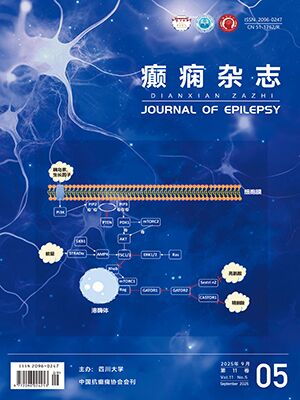| 1. |
范杰, 徐海清, 闫福岭. 症状学研究在发作性疾病中的诊断价值. 医学综述, 2012, 18(22): 3800-3802.
|
| 2. |
Stafstrom CE, Carmant L. Seizures and epilepsy: an overview for neuroscientists. Cold Spring Harb Perspect Med, 2015, 5(6): a022426.
|
| 3. |
Avbersek A, Sisodiya S. Does the primary literature provide support for clinical signs used to distinguish psychogenic nonepileptic seizures from epileptic seizures? J Neurol Neurosurg Psychiatry, 2010, 81(7): 719-725.
|
| 4. |
Auxéméry Y, Hubsch C, Fidelle G. Psychogenic non epileptic seizures: a review. Encephale, 2011, 37(2): 153-158.
|
| 5. |
武豫冬, 李志宏, 李琼仙. 视频脑电图监测发作性疾病 1430 例临床分析. 转化医学杂志, 2016, 5(1): 24-25+41.
|
| 6. |
Pourkalbassi D, Patel P. Conversion Disorder: The Brain's Way of Dealing with Psychological Conflicts. Case Report of a Patient with Non-epileptic Seizures. Cureus, 2019, 11: e3902.
|
| 7. |
刘晓燕 主编. 临床脑电图学. 第 2 版. 北京: 人民卫生出版社, 2017: 92-93.
|
| 8. |
Benbadis SR, O’Neill E, Tatum WO, et al. Outcome of prolonged video-EEG monitoring at a typical referral epilepsy center. Epilepsia, 2004, 45(9): 1150-1153.
|
| 9. |
姚丹, 邓星强. 探究 24 小时动态脑电图在小儿癫痫诊断中的临床应用. 中国妇幼健康研究, 2015, 4(5): 966-967.
|
| 10. |
孟红梅, 李娜, 崔俐, 等. 吉林省部分农村地区癫痫流行病学调查. 中风与神经疾病杂志, 2010, 27(12): 1108-1110.
|
| 11. |
黄茂盛, 洪震, 曾军, 等. 上海市金山区农村癫癎流行病学调查研究. 临床神经电生理学杂志, 2001, (04): 196-198+205.
|
| 12. |
Forsgren L, Beghi E, Oun A, et al. The epidemiology of epilepsy in Europe-a systematic review. Eur J Neurol, 2005, 12(4): 245-253.
|
| 13. |
Theodore WH, Spencer SS, Wiebe S, et al. Epilepsy in North America: a report prepared under the auspices of the globalcampaign against epilepsy, the International Bureau for Epilepsy, the International League Against Epilepsy, and the World Health Organization. Epilepsia, 2006, 47(10): 1700-1722.
|
| 14. |
张涛, 赵玉华, 郝渝, 等. 拉萨地区脑卒中 464 例分析. 中华神经科杂志, 2015, 48(10): 861-865.
|
| 15. |
于振华, 董红, 毛德华, 等. 641 例脑囊虫病致癫痫临床分析. 中风与神经疾病杂志, 2003, (02): 75-77.
|
| 16. |
黄华生, 韦仕荣, 潘鹏克, 等. 脑囊虫病 75 例临床分析. 广西医学, 2015, 37(11): 1671-1673+1676.
|
| 17. |
次仁潘多. 西藏不同海拔高度世居藏族和移居人群高原适应不全的流行病学调查与分子机制研究. 西藏大学, 硕士学位论文, 2017.
|
| 18. |
Frisancho AR. Developmental functional adaptation to high altitude: review. American Journalof human biology, 2013, 25(1): 151-168.
|
| 19. |
Samantha L. Budda Mechanisms of neuronal damage in brain hypoxia/ischemia: focus on the role of mitochondrial calcium accumulation. Pharmacology & therapeutics, 1998, 80(2): 203-229.
|
| 20. |
Busl KM. Hypoxic-ischemic brain injury: pathophysiology, neuropathology and mechanisms. Neuro Rehabilitation, 2010, 26(1): 5-13.
|
| 21. |
Mehta SL, Kumari S, Mendelev N. Selenium preserves mitochondrial function, stimulates mitochondrial biogenesis, and reduces infarct volume after focal cerebral ischemia. BMC Neurosci, 2012, 13(1): 79.
|
| 22. |
Bindokas VP, Lee CC, Colmers WF, et al. Changes in mitochondrial function resulting from synaptic activity in the rat hippocampal slice. J Neurosci, 1998, 18(12): 4570-4587.
|
| 23. |
Blomgren K. Free radicals, mitochondria, and hypoxia-ischemia in the developing brain. Free radical biology & medicine, 2006, 40(3): 388-397.
|




